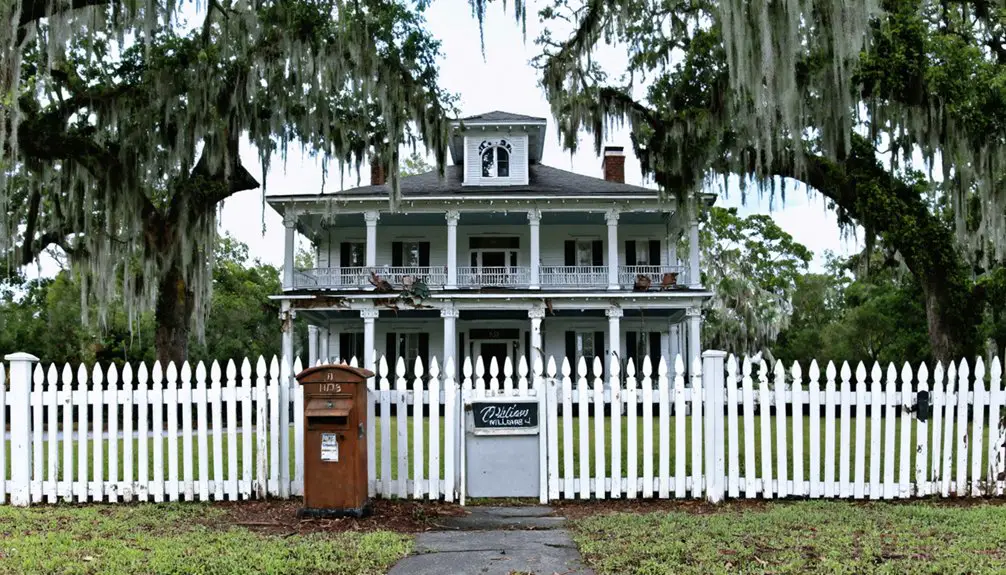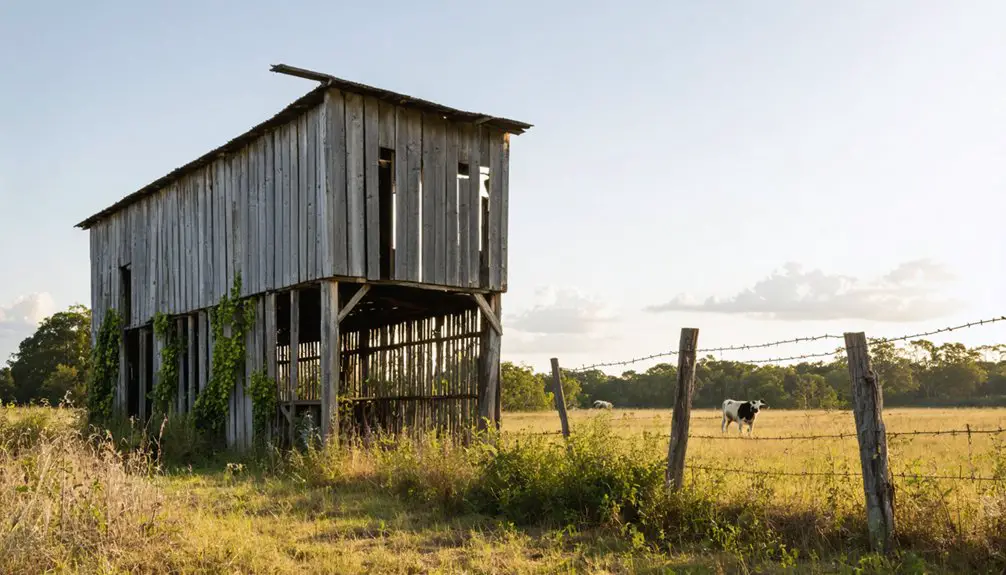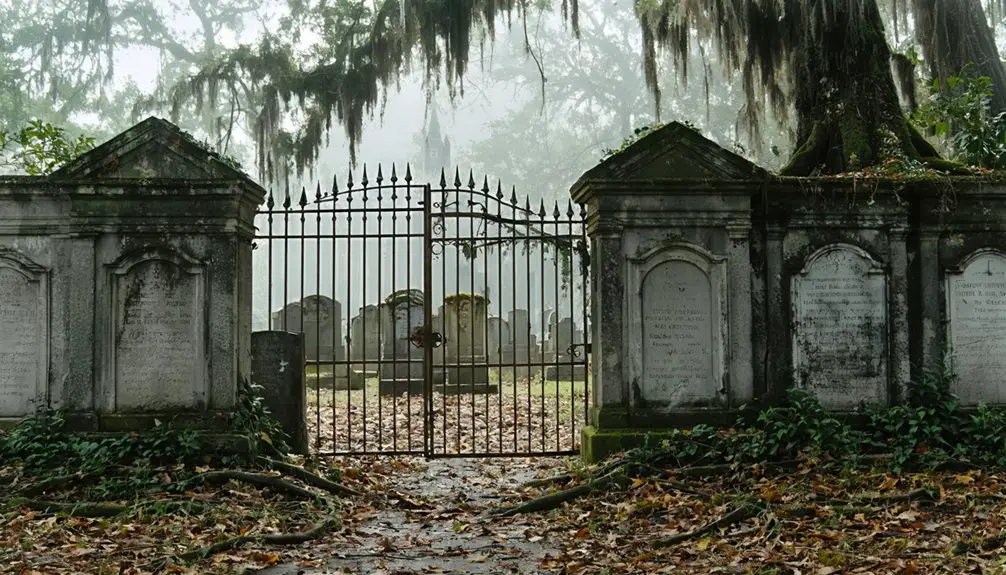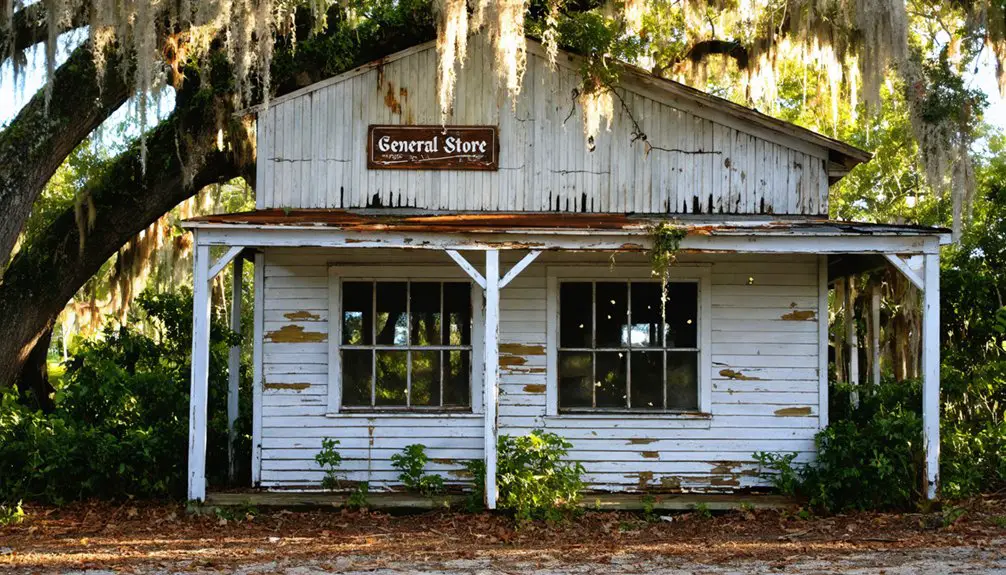You’ll find Venus, Florida at the intersection of two former military trails, where it emerged as a frontier settlement in the mid-1800s. The town flourished through cattle driving, agriculture, and turpentine production, reaching its peak in the 1920s with a general store, school, and church. After the Great Depression and a devastating fire, Venus declined into a ghost town, though you can still explore its architectural remnants and the scattered cattle ranches that preserve its pioneer spirit.
Key Takeaways
- Venus, Florida was established in the mid-1800s at the intersection of military trails and thrived until the 1930s through cattle, agriculture, and turpentine.
- The town reached its peak in the 1920s with concrete infrastructure, a schoolhouse, general store, and church serving the local community.
- A devastating fire and the Great Depression led to Venus’s decline, transforming it from a bustling town into an abandoned settlement.
- Physical remnants include the Venus General Store foundation, old Albritton Store, Florida cracker houses, and ruins of educational and religious buildings.
- The area is now mostly owned by Lykes Brothers, with scattered cattle ranches and citrus farms maintaining some of the town’s agricultural heritage.
Early Settlement and Military Trail Origins
While the name Venus may seem unusual for a Florida settlement, the area first emerged as a community called Fisheating Creek in the mid-1800s at the intersection of two essential military trails.
You’ll find the origins of this frontier outpost deeply connected to the military influence that shaped early Florida. When the U.S. government opened the region to cattle grazing in 1859, the crossroads became a natural gathering point for cattle drivers moving their herds along these crucial pathways.
Much like Venice’s early pioneers who established settlements on Florida’s Gulf Coast, these settlers were drawn by visions of agricultural prosperity. The strategic location attracted settlers who valued both the protection offered by nearby military forts and the economic opportunities of the cattle trails. A sawmill owner later renamed the settlement from Fisheating Creek to Venus. These pioneering residents formed the foundation of a community that would later become known as Venus.
Life in 19th Century Venus
How did settlers carve out a life in 19th century Venus? You’d find agriculture workers and cattle drivers forming the backbone of this resilient community. They’d gather at the general store, church, and school near the railroad tracks – essential hubs for social gatherings in this unincorporated town.
The opening of northern Florida lands to free-range cattle grazing in 1859 brought new opportunities. You could spot cattle drivers using military trails to move their herds, while farmers cultivated citrus groves. Like the Knight family in 1868, early settlers faced the challenges of establishing new lives in this untamed wilderness. Much like Venice’s noble families of medieval times, local landowners competed to build the grandest homesteads in the area.
As cattle drivers and farmers claimed Florida’s open ranges, they forged new paths and planted roots in untamed territory.
The turpentine industry added another layer to Venus’s economic tapestry. Though the population remained small, with families scattered across surrounding ranches and farms, community resilience shone through their shared spaces and commerce.
The town’s strategic location near military forts and railroad tracks supported this flourishing rural lifestyle.
Economic Foundations of a Frontier Town
The economic bedrock of Venus emerged from three key industries in the mid-1800s: cattle driving, agriculture, and turpentine production.
You’ll find that the town’s economic resilience stemmed from its strategic location at the junction of military trails, which facilitated trade and movement of goods. The U.S. government’s 1859 policy opening northern Florida to free-range grazing strengthened Venus’s frontier adaptation. Like John Nolen’s vision for regional agricultural centers, Venus exemplified Florida’s potential for planned development. Today, Venus hosts the Venus Project headquarters on 21 acres of research-focused land.
- Cattle operations thrived as ranchers utilized the open ranges while maintaining protective forts against Seminole territory.
- Agriculture workers established farms, creating a stable year-round economic base.
- Turpentine production from abundant pine forests provided additional revenue streams.
The Rise and Fall of Old Venus
In the mid-1800s, you’d find Old Venus emerging at the junction of military trails in Highlands County, where cattle drivers and agricultural workers established a strategic settlement.
You could witness the town’s prosperity from the 1850s through the 1930s, marked by a thriving general store, school, church, and robust cattle and turpentine industries. Located west of railroad, Old Venus developed into a bustling community that supported local agriculture and commerce.
Your visit to Old Venus today would reveal only scattered remnants of its former glory, as the town succumbed to a devastating fire, economic shifts, and possible flooding from 1920s hurricanes. The area remains under the vast ownership of Lykes Brothers, continuing its agricultural heritage through extensive ranching operations.
Early Settlement and Growth
During the mid-1800s, Old Venus emerged from a humble crossroads known as Fisheating Creek, where two crucial military trails intersected in what would become Highlands County, Florida. The federal government’s policy of opening Northern Florida to free cattle grazing in 1859 attracted pioneering settlers to this strategic location. Much like Bertha Palmer’s ranch, early settlers recognized the region’s potential for cattle operations. The Homestead Act of the 1860s brought an influx of determined settlers seeking to establish new lives in the area.
You’ll find the settlement’s growth was shaped by three key factors:
- Strategic military forts constructed to maintain peace between settlers and Seminole tribes
- The establishment of fundamental infrastructure including the Venus General Store, church, and schoolhouse along CR 731
- The development of a diverse economy based on agriculture, cattle driving, and turpentine production
The community flourished as a crucial stopover point, with homesteaders and cattle drivers establishing roots around these protective fortifications, transforming the wilderness into a bustling frontier town.
Economic Glory Days
Building upon its strategic foundation, Old Venus reached its economic zenith during the prosperous 1920s. You’d have found a bustling town with diverse economic activities, from agriculture and cattle driving to turpentine production. Local entrepreneurs operated multiple grocery stores, while a gas station and boarding house served the growing population.
The town’s economic diversification reflected the community pride of its residents. You could see their confidence in the investments they made: concrete curbs lined the streets, new business foundations emerged, and a three-room brick schoolhouse educated local children.
But this prosperity wouldn’t last. The 1929 stock market crash, combined with the end of Florida’s land boom and the Great Depression, triggered a devastating decline. Local sawmills folded, businesses closed, and by 1933, the school had shut its doors.
Destruction and Abandonment
After reaching its economic peak in the 1920s, Old Venus faced a devastating series of blows that would seal its fate. The transformation into a ghost town began with a catastrophic fire that burned through the settlement, destroying critical infrastructure and leaving only scattered concrete foundations and curbs as silent witnesses.
The environmental impact intensified in the 1930s when:
- Lake Okeechobee’s dike collapsed, flooding the community
- Economic activities like turpentine production and cattle driving declined sharply
- Residents dispersed to surrounding ranches and farms, abandoning the town center
You’ll find few remnants of Old Venus today west of the railroad tracks, where weathered building ruins and the Settlers Cemetery stand as the last physical connections to this once-thriving community.
The wilderness has reclaimed most of the area, with nearby Archbold Biological Station now preserving the surrounding land.
Architectural Remnants and Historic Sites
While little remains of Venus today, several notable architectural remnants and historic sites offer glimpses into this forgotten Florida settlement.
You’ll find the Venus General Store foundation near the railroad tracks, with concrete curbs marking where streets once guided residents through this historic ghost town architecture. The Old Albritton Store still stands along CR 731, alongside a few weathered Florida cracker houses that have withstood time’s passage.
West of the tracks and east of the Baptist Church, you can explore the old town’s footprint, where scattered bricks and broken concrete tell tales of bygone days.
Despite limited historical preservation efforts, the ruins of a school and church remain visible across from the general store site, preserving fragments of Venus’s once-bustling community.
Notable Families and Community Leaders

You’ll find several pioneering families, including the Albrittons, Arnolds, Pearces, Sullivans, and Wilsons, who shaped Venus’s early development from the mid-1800s through the 1930s.
The Albritton family stood out particularly for operating the town’s essential general store on CR 731, which served as both a commercial hub and community gathering place.
Religious leadership emerged through the Venus United Methodist Church, where clergy members guided the spiritual life of settlers while maintaining the historic Settlers Cemetery, now known as the Venus United Methodist Church Cemetery.
Early Pioneer Settlers
The early pioneer families who settled Venus, Florida established themselves amid dense wilderness approximately three miles west of what would become U.S. Highway 27.
These brave settlers faced intense challenges while carving out pioneer lifestyles in this remote region, where sawmill operations became their primary economic foundation.
- The Waldron family, led by Civil War veteran David Elias Waldron Sr., constructed one of the area’s first cabins.
- The Daughtrey brothers arrived from Tennessee in the 1860s, establishing themselves as cattle runners along the Kissimmee River Valley.
- William Henry Willingham and the Underhill family developed cattle operations near Kissimmee Island, despite difficult supply routes.
You’ll still find weathered Florida cracker houses and old sheds dotting the landscape, silent witnesses to these settlers’ determination to build lives in Florida’s untamed wilderness.
Important Albritton Family Members
Among Venus’s pioneering families, Thomas Henry Albritton left an indelible mark on the region’s development after homesteading in Florida during the 1840s. Known as “Captain Tom,” he raised nine children and established a family legacy that would shape Venus’s future.
His son Tom founded the Albritton Fruit Company in 1880, which became Florida’s oldest continuously operating family business.
The Albritton heritage reached new heights under Karl Benjamin Albritton, Tom’s grandson. Karl revolutionized citrus farming by inventing the first hedging machine and expanding operations from 20 to 1,600 acres.
He’d later be inducted into both the Florida Agriculture and Citrus Halls of Fame. The family’s influence extended beyond agriculture, as they operated Venus’s general store and maintained strong ties to the local cemetery and Methodist church.
Venus Religious Leaders
Since its earliest days as a settlement, Venus’s religious landscape was profoundly shaped by Catholic missionaries and clergy from the Diocese of Venice in Florida. The area’s spiritual foundation dates back to 1567 when Jesuit missionaries established Mission San Antón de Carlos near modern-day Venus, marking the first western hemisphere Jesuit presence in the region.
Venus clergy and their community outreach evolved through three distinct phases:
- 16th-century Jesuit missionaries like Juan Rogel and Francisco de Villareal, who studied local languages and evangelized the Calusa peoples.
- Late 19th-century itinerant priests who traveled from Tampa to serve scattered Catholic settlements.
- Modern Diocese leadership under Bishops John J. Nevins and Frank J. Dewane, who’ve continued the tradition of active community engagement through local parishes and missions.
The Legacy of Florida’s Cattle Industry

When Juan Ponce de Leon brought the first cattle to Florida in 1521, he unknowingly launched North America’s earliest cattle industry. By the 1600s, Florida boasted 34 ranches with 20,000 head of cattle, establishing itself well before other famous cattle states.
You’ll find that Florida’s cattle ranching legacy continues today, ranking among the nation’s top producers with nearly 900,000 head of cattle generating over $900 million annually.
Through genetic improvement programs combining Brahma, British, and native Cracker cattle, Florida’s ranchers have doubled their calf crop percentages since the mid-20th century.
The state’s seedstock producers now provide elite genetics to herds worldwide. You’ll see this legacy preserved across Florida’s landscape, where nearly half of all agricultural land supports cattle production, helping protect natural grasslands and wildlife habitats from urban development.
Turpentine and Timber Operations
The turpentine industry established deep roots in southern Florida‘s virgin long leaf pine forests during the late 1800s, as operations migrated south from the depleted Carolinas.
As pine forests vanished in the Carolinas, turpentine operations found new life in Florida’s untapped wilderness during the 1800s.
In Venus, you’ll find remnants of this once-thriving industry where workers used traditional turpentine techniques to extract valuable sap from pine trees.
The timber trade and turpentine operations near Venus followed these essential steps:
- Workers carved distinctive “catfaces” into pine trunks and created collection boxes.
- They gathered roughly 50 gallons of sap to produce 325 pounds of pitch and 10 gallons of turpentine.
- The resin was transported to distillation sites for processing into naval stores and industrial products.
Sacred Ground: The Settlers Cemetery

Among Venus’s most enduring landmarks, Settlers Cemetery stands at 962 County Road 731 as a tribute to the area’s pioneering spirit.
You’ll find this sacred ground officially established in 1887 when the Florida Mortgage and Investment Company deeded the land, though burials began in the 1880s.
As you explore the cemetery’s quiet wilderness setting, you’ll discover over 350 graves of Venus’s founding families, including the Albrittons, Arnolds, and Platt clans.
These sacred memories trace back to the days when Venus United Methodist Church served as the community’s spiritual anchor.
Today, while the ghost town of Venus has faded into history, the cemetery endures as a memorial to pioneer heritage, preserving the names and stories of those who carved civilization from Florida’s untamed frontier.
Exploring Venus Today
Seeking traces of old Florida’s frontier spirit, you’ll find Venus tucked away in a remote stretch between Fort Myers and Moore Haven.
Take US-27 north from Moore Haven, then head west toward Old Venus near Palmdale to discover this cultural significance of this forgotten settlement.
- The old general store’s foundation and concrete curbs still mark the town’s heart near the railroad tracks.
- Several weathered Florida cracker houses stand as silent witnesses to pioneer life.
- The surrounding wilderness of palms, pines, and Everglades creates an untouched backdrop.
Modern challenges haven’t completely erased Venus’s essence – scattered cattle ranches and citrus farms continue the agricultural tradition around the original site.
While most structures have vanished, the quiet isolation preserves the authentic feel of early Florida settlement life.
Frequently Asked Questions
What Caused the Devastating Fire That Destroyed Old Venus?
You can’t pinpoint the exact fire origins that destroyed Old Venus, as historical artifacts and records don’t document the specific cause – only that the town burned down sometime after 1930.
Are There Any Paranormal Activities Reported in the Venus Ghost Town?
You won’t find documented ghost sightings or haunted locations in Venus. Despite its abandoned state and eerie atmosphere, there’s no credible evidence of paranormal activity in this old Florida settlement.
Why Was the Unusual Name “Venus” Chosen for This Settlement?
You’ll find the naming origins remain a mystery, though records show Venus emerged in the 1850s. While locals speculate it’s linked to classical mythology, there’s no documented reason for this unusual choice.
Did Any Famous Outlaws or Historical Figures Pass Through Venus?
You won’t find any famous outlaws or notable historical figures in Venus’s history. Records show it was primarily populated by local farming families, cattle drivers, and settlers near Seminole territory.
Can Visitors Legally Explore the Old Venus Ruins Today?
You’ll need landowner permission since most ruins are on private property. While there aren’t explicit “No Trespassing” signs, visitor access isn’t officially permitted without prior arrangements for exploration.
References
- https://historicarchaeology.weebly.com/journal/venus-in-florida-ghost-town-101
- https://www.florida-backroads-travel.com/old-venus-a-florida-ghost-town.html
- https://www.ghosttowns.com/states/fl/oldvenus.html
- https://www.youtube.com/watch?v=VjlbiOjLqWw
- https://www.itsfloridacountry.com/exploring-floridas-best-ghost-towns-and-abandoned-places/
- https://www.venicebeachvillas.com/blog/the-history-of-venice-florida-tracing-the-roots-of-this-coastal-community/
- https://www.visitvenicefl.org/the-history-of-venice/
- https://www.gulfshoresrealty.com/history-of-the-venice-area.php
- https://www.youtube.com/watch?v=ZiHRE1muC94
- https://stars.library.ucf.edu/cgi/viewcontent.cgi?article=1159&context=fhq



